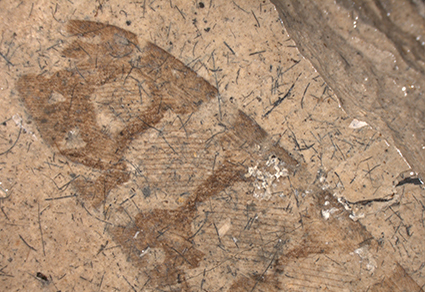Abstract
Iphigensia storozhenkoi gen. et sp. nov. (Neuroptera: Nymphidae) is described from the Middle-Upper Jurassic of Kazakhstan based on an almost complete forewing. The Iphigensinae subfam. nov. is proposed to accommodate this genus, which is characterized by a unique venation pattern and presence of contra radial sector (Crs): this is an additional longitudinal vein, formed by the fusion of the proximal branches of RP, and unknown in both extant and other fossil lacewings. Discovery of Iphigensia gen. nov. with derived venation suggests that early radiation of Myrmeleontoidea was more extensive than previously thought.
References
- Archibald, B.S. & Makarkin, V.N. (2020) A new genus and species of split-footed lacewings (Neuroptera) from the early Eocene of western Canada and revision of the subfamily affinities of Mesozoic Nymphidae. The Canadian Entomologist, 152, 269–287. https://doi.org/10.4039/tce.2020.10
- Breitkreuz, L.C.V., Winterton, S.L. & Engel, M.S. (2017) Wing tracheation in Chrysopidae and other Neuropterida (Insecta): a resolution of the confusion about vein fusion. American Museum Novitates, 3890, 1–44. https://doi.org/10.1206/3890.1
- Carpenter, F.M. (1929) A Jurassic neuropteran from the lithographic limestone of Bavaria. Psyche, 36, 190–194. https://doi.org/10.1155/1929/12134
- Doludenko, M.P., Sakulina, G.V. & Ponomarenko, A.G. (1990) The geology and Late Jurassic fauna and flora of a unique locality Aulie (Karatau Mountains, southern Kazakhstan). Geologicheskii institut AN SSSR, Moscow, 38 pp. [in Russian]
- Heads, S.W., Martill, D.M. & Loveridge, R.F. (2005) An exceptionally preserved antlion (Insecta, Neuroptera) with colour pattern preservation from the Cretaceous of Brazil. Palaeontology, 48, 1409–1417. https://doi.org/10.1111/j.1475-4983.2005.00514.x
- Khramov, A.V. & Chemakos, M.A. (2022) A new species of Cretapsychops (Insecta: Neuroptera: Psychopsidae) from the Upper Jurassic of Kazakhstan. Paleontological Journal, 56, 194–198. https://doi.org/10.1134/S0031030122010087
- Khramov, A.V., Liu, Q. & Zhang, H. (2019) Mesozoic diversity of relict subfamily Kempyninae (Neuroptera: Osmylidae). Historical Biology, 7, 938–946. https://doi.org/10.1080/08912963.2017.1411351
- Liu, X.-Y., Lu, X.-M., Wang, J.-L., Xu, C.-P. & Zhuo, D. (2025) A new moth lacewing genus (Insecta: Neuroptera: Ithonidae) with proliferated and specialized wing venation from the mid-Cretaceous of northern Myanmar. Palaeoentomology, 8, 36–46. https://doi.org/10.11646/palaeoentomology.8.1.6
- Linnaeus, C. (1758) Systema naturae per regna tria naturae secundum classes, ordines, genera, species, cum characteribus, differentiis, synonymis, locis. Vol. 1. 10th Edition. Salvii, Holmiae, 824 pp. https://doi.org/10.5962/bhl.title.542
- Lu, X., Zhang, W., Ohl, M. & Liu, X. (2017) The first moth lacewing (Insecta: Neuroptera: Ithonidae) from the mid-Cretaceous amber of Myanmar. Cretaceous Research, 78, 78–83. https://doi.org/10.1016/j.cretres.2017.05.027
- Makarkin, V.N. (2016) The amazing diversity of Cretaceous Neuroptera. A.I. Kurenstov’s Annual Memorial Meetings, 27, 27–47. [in Russian]
- Makarkin, V.N. (2017) Oldest new genus of Myrmeleontidae (Neuroptera) from the Eocene Green River Formation. Zootaxa, 4337 (4), 540–552. https://doi.org/10.11646/zootaxa.4337.4.5
- Makarkin, V.N. (2022) A new important species of Nymphidae (Neuroptera) from the Lower Cretaceous Crato Formation of Brazil. Zootaxa, 5175 (3), 377–382. https://doi.org/10.11646/zootaxa.5175.3.4
- Menon, F. & Makarkin, V.N. (2007) First record of fossil ‘rapismatid-like’ Ithonidae (Insecta, Neuroptera) from the Lower Cretaceous Crato Formation of Brazil. Cretaceous Research, 28, 743–753. https://doi.org/10.1016/j.cretres.2006.11.003
- New, T.R. (1985) A revision of the Australian Myrmeleontidae (Insecta: Neuroptera). I. Introduction, Myrmeleontini, Protoplectrini. Australian Journal of Zoology, Supplement Series, 104, 1–90. https://doi.org/10.1071/AJZS104
- Panfilov, D.V. (1968) Kalligrammatid lacewings (Neuroptera: Kalligrammatidae) from the Jurassic deposits of Karatau. In: Rodendorf, B.B. (Ed.), Jurassic Insects of Karatau. Nauka, Moscow, pp. 166–174. [in Russian]
- Ren, D. & Engel, M.S. (2007) A split-footed lacewing and two epiosmylines from the Jurassic of China (Neuroptera). Annales Zoologici, 57, 211–219.
- Rambur, J.P. (1842) Histoire Naturelle des Insectes, Nevropteres. Fain et Thunot, Paris, 534 pp.
- Shi, C., Makarkin, V.N., Yang, Q., Archibald, B. & Ren, D. (2013) New species of Nymphites Haase (Neuroptera: Nymphidae) from the Middle Jurassic of China, with a redescription of the type species of the genus. Zootaxa, 3700 (3), 393–410. https://doi.org/10.11646/zootaxa.3700.3.4
- Shi, C., Winterton, S.L. & Ren, D. (2015) Phylogeny of split-footed lacewings (Neuroptera, Nymphidae), with descriptions of new Cretaceous fossil species from China. Cladistics, 31, 455–490. https://doi.org/10.1111/cla.12104
- So, K.S. & Won, C.G. (2022) A new fossil lacewing (Ithonidae) from the Lower Cretaceous (Barremian-Aptian) Sinuiju Formation, Democratic People’s Republic of Korea. Cretaceous Research, 138, 105288. https://doi.org/10.1016/j.cretres.2022.105288
- Yang, Q., Makarkin, V.N., Shi, C. & Ren, D. (2013) The presence of the recurrent veinlet in the Middle Jurassic Nymphidae (Neuroptera): a unique character condition in Myrmeleontoidea. ZooKeys, 325, 1–20. https://doi.org/10.3897/zookeys.325.5453


